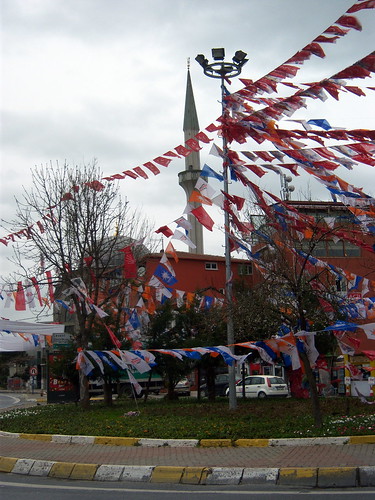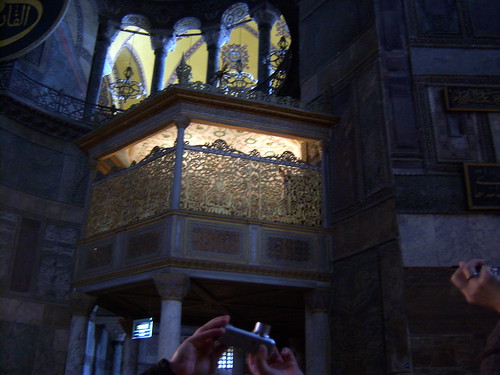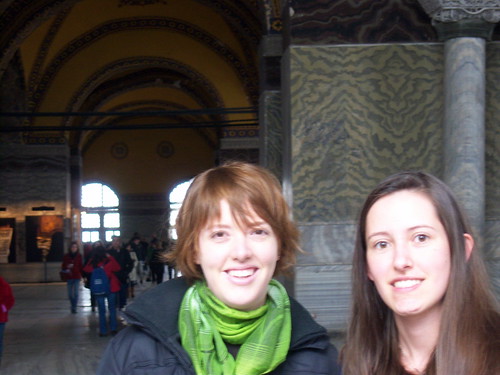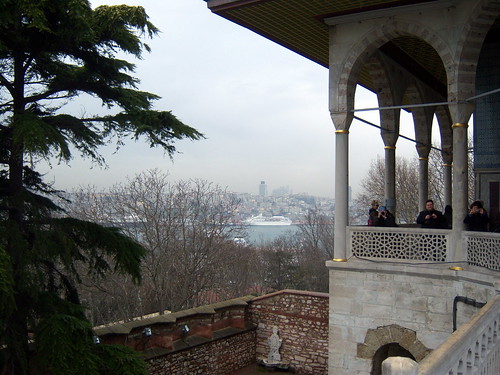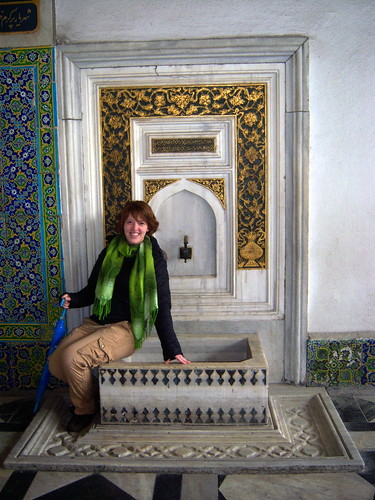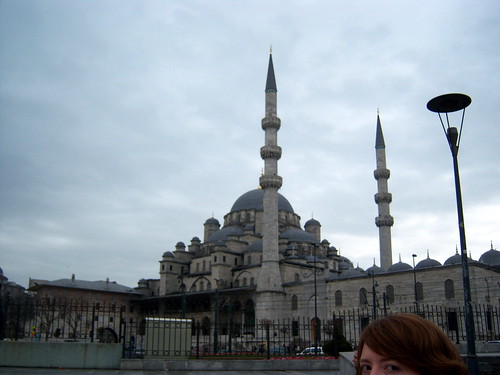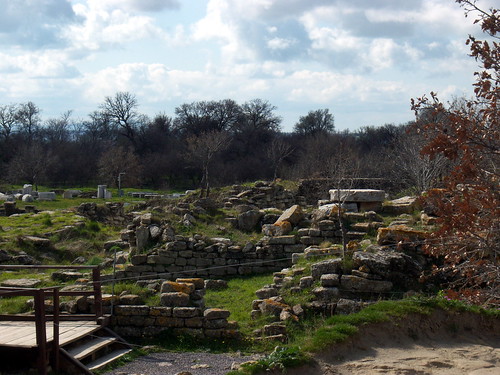Hey folks,
I figured I should start at the beginning of my 'Highlights of Turkey' week with Danaijo, so I'll back up to the Saturday before last, when I had a day to spend in Istanbul before picking D up at the airport that evening. I'd stayed with my friend Cat, of my previous Kartalkaya adventure, so we headed out bright and early for some menemen (by far my favorite Turkish breakfast food, and what would be my favorite Turkish food ever, if not for the wondrousness of manti). Cat has a local
menemenci across the street from her, so we had breakfast al fresco and I learned about the shop's rad intercom system: the shop supplied tea to all the shops in the neighborhood, but it wasn't efficient to just send a kid around constantly and ask if folks wanted tea, so there were several intercoms located around the neighborhood, in shops and on the street, and shopkeepers would just buzz over when they needed a glass or two. The speaker was above the cooking surface, so the menemen guy'd listen to Ahmet from around the corner saying he needed 3 glasses, send off the tea boy, and continue cooking. Brilliant. I cannot believe I've lived here so long and not noticed this ingenious system. At least I've noticed the cab call boxes...
Thusly fortified, Cat and I set off up towards Etiler to photograph some election flags. Local elections are at the end of March, and the parties are going
all out: in addition to the household appliances mentioned in an earlier post, flags from the major parties are everywhere in the cities, blanketing major intersections, and vans with candidates' photos plastered to their sides drive around all day blaring patriotic party campaign music. A particularly catchy one in Antakya (sadly for Danaijo, it was stuck in my head the rest of our trip) just repeated "Simdi CHP zamani!" ("Now is CHP time!") ad nauseam. Anyway, we photographed our way to Besiktas, where we parted in a pouring rain after stocking up on bootleg dvds; while I was on the hunt for a travel book that included Syria, Cat ended up at a CHP rally with a bunch of politically-active women from GOP (in Ankara, that's the ritzy neighborhood, but in Istanbul, it's one of the more distressed neighborhoods).
I ended up not minding about missing 6 hours of party speeches and songs, because while walking around Tourist Central, Istanbul, I picked up something mythical and wonderful: a MuzeKart. For background, in August the government raised prices for all museums and sites it manages (so, pretty much everything but Dolmabahce Palace and the Basilica Cisterns), while removing the option of a student discount. This meant that Topkapi, had I had the urge to go see both the main part and the Harem part, would have been 35 lira just for me. I felt this to be outrageous, and thus hadn't seen Topkapi, but I did cough up 20 lira for the Hagia Sophia. There is one way to avoid having to pay (outrageous amount) for all those tourist sites: buy a MuzeKart. This 20-lira card, with your photo badly scanned to the back, allows you in to all state-run sites across Turkey for free, for a year. Awesome. The only catch is that it's only for Turkish citizens. No 20-lira pass for yabancis. I had heard, though, that within the past month the rules had relaxed enough to allow students at Turkish universities to also buy MuzeKarts, at a discounted price of 10 lira (because they're, you know, poor students). Armed with my ODTU ID, I braved the line at the Hagia Sophia to try my luck...and it worked! I didn't want to say anything while getting it in case they decided I didn't sound Turkish enough, but mere hours before picking up D I had scored a 10-lira card that would halve our total admission costs at every museum we visited (aside from the Cisterns, but I successfully argued for the Turkish student discount there).
So, fresh from my exciting MuzeKart buying, I headed off to the airport. Apparently at Ataturk International one is not allowed into the baggage claim area if one has not just disembarked from a plane, so I hung out with a bunch of liveried drivers with fancy name-signs, looking for American-looking people as they departed baggage claim. After a group with matching Yale sweatshirts trundled by, Danaijo walked out, and we had our emotional reunion before heading down to the Metro to head back to Sultanahmet. Once settled at our hotel, we then had to get back on the light rail line, take it to the end, hop on a bus, and slowly make our way through rush hour traffic to meet up with Cat for dinner in Arnavutkoy. This would've worked much better if the bus we were on had gone to Arnavutkoy. Instead, we took an unexpected turn in Ortakoy and ended up in some bus depot, with a confused driver asking where exactly we wanted to go. Oboy. I'd even asked when we got on if the bus went to Arnavutkoy.
No matter, we got on another bus, and headed back to Ortakoy, where we took a quick detour through the handicrafts bazaar there on the waterfront before grabbing a cab to Arnavutkoy. Once finally there, we grabbed Cat for dinner at Bodrum Manti (if you've read my other Istanbul entries, you may recognize the name; this is because Bodrum Manti is perhaps my favorite restaurant in Istanbul), where D had her first authentic Turkish meal, kitir ispanakli manti, or fried spinach manti.
Given that D had just gotten off a double-digit-hours-long plane ride, we didn't do much else til the next morning, when we headed out bright and early to the Aya Sofia, before heading to the Basilica Cisterns (they're just cool; I think I've been there 3 times now, and I never get tired of them). After the Cisterns, we headed over to the Blue Mosque before noticing that it was closed for prayer time, so we ambled over to Topkapi, stopping for fresh-squeezed pomegranate juice en route. Topkapi was, in a word, overwhelming. We passed through gate after gate, entering room after room, all absolutely gorgeously decked out in the heights of Ottoman fashion. Detail was everywhere. Tiles were handpainted. Pillows and sofas were richly embroidered with silver and gold thread. Mother-of-pearl inlay was on quite a bit of the woodwork. It was gorgeous. We went a little out of order through Topkapi, and ended up at the very back, where the private quarters open up to a view of both Europe and Asia across the Bosphorous. I simply cannot use enough adjectives to describe the opulence of the setting or the Palace itself. After the Sultan's family quarters, we went through the Treasury. If I said the rest of Topkapi was overwhelming, this was at least triply so. It felt like going through House on the Rock (in Wisconsin, also a cool site, but not quite so pedigreed as Topkapi). There were jewels and thrones and artifacts from the Royal Family. There were medals and awards. But most impressively, there were religious and historical artifacts ostensibly from pretty much all the major players in Muslim (and therefore Judeo-Christian) accounts. There was Moses' staff. Swords from Mohammed aas well as from all his major male associates. The Prophet's beard hair. Other relics from Old Testament prophets. The hand of St. John. The
head of St. John. The artifacts went on and on, winding through rooms to the sound of the Quran being read aloud. We figured at first that it was a recording, til we turned a corner towards the end and ran into a little cleric perched on a stool, singing the text into a microphone in front of him as screens to the side scrolled the Turkish and English translation of the verse he was currently singing. Pretty cool.
By that time we had seen so much, my eyes were aching, so we wandered over to the Galata Bridge, where we snagged a few beanbag chairs and had lunch while watching the fishermen above us and the boats below us. Quite nice. After lunch, we went through the Spice Bazaar and its side streets, and spent an enjoyable time haggling over some copper pots and coffee sets. With those purchases in hand, we headed back towards the Blue Mosque to try and find a carpet shop. Normally I avoid carpet shops like the plague, but D had mentioned maybe buying a carpet if she could find a good deal, so we stuck our heads into a shop, to see what we could find. The guys in the shop were naturally quite friendly, and eager to show us 'just the perfect' carpets. They piled up carpet after carpet on the floor, asking us to mention when we saw ones we liked, so they could set those aside to cull the pile slowly but surely. Unfortunately, they didn't show any kilims until I specifically asked, and even then just brought out one half-hali half-kilim, and a few brand-new, machine-made kilims that were as soulless as any beige wall-to-wall. D quite liked the half-and-half carpet, so I asked how much they wanted for it so we could start working our way down. Their original asking price was literally over 4 times what the carpet should have been. Were we wiser, we'd have walked out immediately. Since we weren't that wise in the ways of carpet shops yet, I expressed shock at the outrageous price, and reminded the salesguy that we were students (...close enough) on limited budgets. We managed to knock a few hundred off the price before we decided it was time to check out the selection at a few of the neighboring shops. While we were packing up, we kept chatting, and the salesguy lowered the price significantly. He really didn't want us to check out other shops. We headed out anyway, with the promise that we'd return, as I was hoping that the selection in other shops would be at least closer to what I'd seen in Diyarbakir. Unfortunately, Sunday afternoon is not a popular carpet-buying time, and the other shops either didn't have a great selection, had no staff, or argued with D when she told them she wanted to see pieces with kilim elements. So back we went to the first shop, where after much more discussion and side ponderings on the merits of a few smaller rugs, we felt like we could make a deal, and for a decent price: 500-600 for a medium-sized half-hali half-kilim for D, plus a newer smaller kilim for me. We were within one hundred lira of our tipping point with the salesguy, and finally got him down to our price. Fantastic, no? Wrong! At that point, the owner of the shop (who had been observing, with the occasional comment) stepped in to say that the price for D's rug was 1800, and that there was absolutely no way he would consider going under 1800. What??? We were not amused. (It definitely was not an 1800 lira carpet) We marched out, and decided that carpets were not going to be an Istanbul purchase on our trip. With that enlightening shopping experience under our belts, we picked up our luggage and headed to the Otogar, where we grabbed a bus out to Canakkale that evening. And that will have to be another blog entry, where D and I take perhaps the most circuitous route ever between Istanbul and Ankara.
A quick note on post-travel goings-on: I finally, after a year and a half here, have made it to a football match. I've actually made it to 2, one for Ankaragucu and one for Genclerbirligi (both local Ankarali teams). Both times 'my' team didn't win, or even score, but it was pretty darn fun; today's match featured a hockey-style body check. I've also been meeting up with a few of the other Ankara Fulbrighters, including a new Fulbrighter just in from Greece, and got to an ARIT lecture on historical embroidery which was actually quite charming. It's been busy.
But more of that inshallah in the next post,
-R
